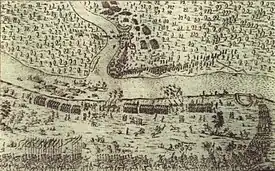| Battle of Loyew (1651) | |||||||
|---|---|---|---|---|---|---|---|
| Part of the Khmelnytsky Uprising | |||||||
 The Battle of Loyew (1651) on the Polish–Lithuanian painting by Abraham van Westerveld in the XVII century | |||||||
| |||||||
| Belligerents | |||||||
|
|
| ||||||
| Commanders and leaders | |||||||
|
|
| ||||||
| Strength | |||||||
|
|
| ||||||
| Casualties and losses | |||||||
| 6,500–8,000 killed and wounded[1] | 6,000–7,000 killed and wounded[2] | ||||||
The Battle of Loyew (Belarusian: Бітва пад Лоевам, Ukrainian: Битва під Лоєвом, Polish: Bitwa pod Łojowem; 6 July 1651) was fought between the Polish–Lithuanian Commonwealth against the Cossack Hetmanate as a part of the Khmelnytsky Uprising. Near the site of the present-day town of Loyew on the Sozh River in Belarus, the Polish–Lithuanian Commonwealth’s forces under the command of Prince Janusz Radziwiłł and Mirski attacked and defeated a forces of the Zaporozhian Cossacks under the command of Colonels Martyn Nebaba, Stepan Pobodailo and Prokip Shumeyko with Lytvynenko.
The tactical situation in the summer of 1651 in the Polish–Lithuanian theater of clashes was not in favor of the Zaporozhian Cossacks. The Polish–Lithuanian Commonwealth’s forces under the command of Prince Janusz Radziwiłł were numbered around 40,000 men was moving towards Chernihiv with the subsequent strategic goal of capturing Kyiv. To counteract him from Podillia after the campaign of the Zaporozhian Cossacks under the command of Otaman Tymofiy Khmelnytsky against the Principality of Moldavia. Colonel Martyn Nebaba was sent to help the already active group of the Zaporozhian Cossacks under the command of Colonel Stepan Pobodailo. Upon arrival, Colonel Martyn Nebaba realized that organized resistance would not work, since the Zaporozhian Cossack’s military units were scattered within the territories of Gomel and Chernihiv. The speed of advance of the Polish–Lithuanian Commonwealth’s forces did not allow grouping in an area convenient for the Zaporozhian Cossacks; in the current situation, Colonel Martyn Nebaba decided to use short blows to slow down the advance of the Poles and Lithuanians to Chernihiv as much as possible, which needed to be strengthened for the siege. For this purpose, blows were struck and the Polish–Lithuanian Commonwealth’s forces in the area of the town of Ripky when crossing to the Left-Bank of the Dnipro River, but this operation did not have deep successes and the Zaporozhian Cossacks had to limit themselves to the Polish–Lithuanian military convoy and victory over 1,500 Polissian Polish–Lithuanian militia. In order to gain time, Colonel Martyn Nebaba sent a military convoys which was led by Colonel Stepan Pobodailo to Prince Janusz Radziwiłł, but he did not consider the negotiations a reason to stop the offensive and sent squadrons of dragoons south of Loyew to the area of the city of Lyubech. In the current situation, Colonel Martyn Nebaba had to accept a general battle and give the opportunity to the other Colonel Stepan Pobodailo to retreat to Chernihiv and strengthen it.
At the first stage of the battle, the Zaporozhian Cossack’s positions fortified with carts were attacked by the German mercenaries called landsknechts who’s helping the Polish–Lithuanian Commonwealth, but the general assault of the Polish–Lithuanian infantry did not give immediate success due to the dense musket fire of the Zaporozhian Cossacks. Then, under the cover of darkness, the Polish–Lithuanian winged hussar’s cavalry corps and squadrons of the Crown Army attacked a forces of the Zaporozhian Cossacks from the rear. In a fierce battle, casualties and losses of the Zaporozhian Cossacks was numbered around 6,000–7,000 men and the casualties and losses of the Polish–Lithuanian Commonwealth’s forces was numbered around 6,500–8,000 men, including the entire Polish–Lithuanian winged hussar’s corps and squadrons under the command of Mirski.
References
Sources
- Marcin Domagała: Biała Cerkiew 23-25 IX 1651. Zabrze: "Inforteditions", 2007. ISBN 8389943158.
- Władysław Andrzej Serczyk: Na płonącej Ukrainie. Dzieje Kozaczyzny 1648–1651. Warszawa: Książka i Wiedza, 1998, p. 347. ISBN 83-05-12969-1.
- Natalia Jakowlenko: Historia Ukrainy. Od czasów najdawniejszych do końca XVIII wieku. Lublin: Instytut Europy Środkowo-Wschodniej, 2000, p. 228. ISBN 83-85854-54-1.
- Tadeusz Korzon: Dzieje wojen i wojskowości w Polsce. Lwów: Ossolineum, 1923, p. 339.


